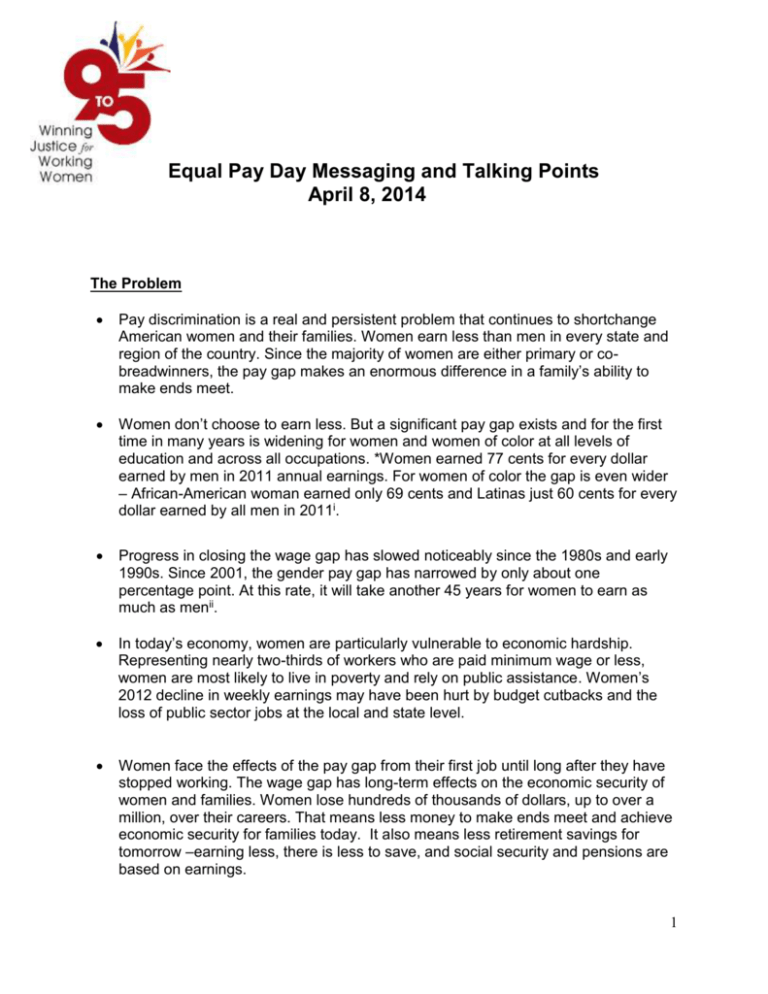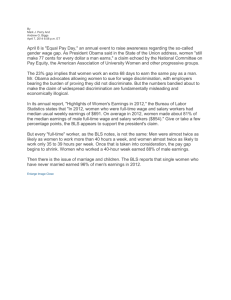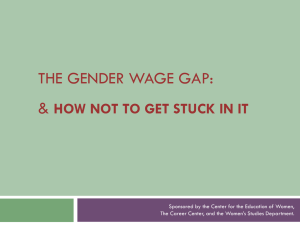Talking Points and Messaging
advertisement

Equal Pay Day Messaging and Talking Points April 8, 2014 The Problem Pay discrimination is a real and persistent problem that continues to shortchange American women and their families. Women earn less than men in every state and region of the country. Since the majority of women are either primary or cobreadwinners, the pay gap makes an enormous difference in a family’s ability to make ends meet. Women don’t choose to earn less. But a significant pay gap exists and for the first time in many years is widening for women and women of color at all levels of education and across all occupations. *Women earned 77 cents for every dollar earned by men in 2011 annual earnings. For women of color the gap is even wider – African-American woman earned only 69 cents and Latinas just 60 cents for every dollar earned by all men in 2011i. Progress in closing the wage gap has slowed noticeably since the 1980s and early 1990s. Since 2001, the gender pay gap has narrowed by only about one percentage point. At this rate, it will take another 45 years for women to earn as much as menii. In today’s economy, women are particularly vulnerable to economic hardship. Representing nearly two-thirds of workers who are paid minimum wage or less, women are most likely to live in poverty and rely on public assistance. Women’s 2012 decline in weekly earnings may have been hurt by budget cutbacks and the loss of public sector jobs at the local and state level. Women face the effects of the pay gap from their first job until long after they have stopped working. The wage gap has long-term effects on the economic security of women and families. Women lose hundreds of thousands of dollars, up to over a million, over their careers. That means less money to make ends meet and achieve economic security for families today. It also means less retirement savings for tomorrow –earning less, there is less to save, and social security and pensions are based on earnings. 1 The Solution Pass the Paycheck Fairness Act (S. 84/H.R. 377) which was reintroduced in Congress in January 2013. The PFA would close loopholes in our existing equal pay laws, prohibit retaliation against workers who ask about or share wage information, and empower women to better negotiate salary and benefit increases. Equal work deserves equal pay. The PFA would play a critical role in our nation’s economic recovery. Every cent counts in these tough economic times, when more women are primary family breadwinners or co-breadwinners than ever before. Wage discrimination must end. Pay equity is good for the economy and working families – it reduces poverty, stimulates the economy and increases women’s economic security. It reduces stress-related health problems and health care costs. There is a business case for pay equity. Providing pay equity and offering workplace flexibility helps employers recruit and retain the most qualified employees in their field, and is proven to increase productivity and profits. Fortune Magazine’s “100 Best Companies to Work for in America” all have extensive workplace flexibility policies. How We Get There We can’t make real progress in closing the wage gap until we strengthen enforcement of existing anti-discrimination laws and give women the tools they need to get the pay they deserve. Strong enforcement of our equal pay laws is one important step to ending discrimination and closing the pay gap. We need to tackle discrimination, properly value women’s care work, and create better policies and programs to educate and train women for higher paying jobs. We should ask our legislators to support workplace and public policies for paid sick days and family leave insurance, a minimum wage increase including for tipped workers, and provide equity for part-time and temp workers. Women voters were instrumental in sending many new lawmakers to Congress – including a record number of women - now we have to hold their feet to the fire. Call to Action Now is the time to stand up for equal pay! Mark your calendar for Equal Pay Day on April 8, 2014. Stay tuned for updates about events in your area. If you would like to 2 host your own Equal Pay Day event, contact Lindsey at lindsey@9to5.org or call 1800-669-0769 for more information. Contact your U.S. Senator and Representatives and ask them to co-sponsor and support the Paycheck Fairness Act! Background on Equal Pay Day Tuesday April 8, 2014, is Equal Pay Day, the date we recognize and protest the wage gap that exists between working women and men and between workers of color and white workers across the country. Tuesday symbolizes how far into a second week a woman must work, on average, to earn as much as a man earned in the previous week. April represents how far into a new year women must work to earn what men earned just in the previous year. Protestors and advocates wear red to show that pay for women and people of color is still in the red. Statistics Women's annual earnings were 77.0 percent of men's in 2011, compared to 77.4 percent in 2010, according to Census statistics based on the median earnings of all full-time, year-round workers. Men's earnings in 2011 were $48,202 and women's were $37,118, a difference of $11,084.iii In 2011, the earnings of African American women were $33,501, 69.5 percent of all men's earnings, a slight increase from 67.7 percent in 2010, and Latinas' earnings were $29,020, 60.2 percent of all men's earnings, up from 58.7 percent in 2010. Asian American women's earnings at $40,882 dropped from 86.6 percent of all men's earnings in 2010 to 84.8 percent in 2011.iv In 2012, the ratio of women’s to men’s median weekly full-time earnings was 80.9 percent, a decline of more than one percentage point since 2011 when the ratio was 82.2 percent. This corresponds to women’s $691 median weekly earnings in 2012 compared to men’s $854 median weekly earnings. Women make up an estimated 49 percent of the workforce, but 59 percent of the low-wage workforce. In six out of ten families, a mother is the primary or co-breadwinner.v The typical woman loses $431,000 in pay over a 40-year careervi. 3 In almost all of the hundreds of occupations tracked by the U. S. Bureau of Labor Statistics, women earn less than men. Even when all other things are factored in – like education, experience in the workforce, marital status, number of children – there is still a pay gap that remains unexplained. About 9to5: With forty years’ experience in winning justice for working women, 9to5 leads the way to create a powerful force for change on issues affecting low-wage women and their families. 9to5 organizes women to lead campaigns for familysupporting jobs with decent wages and paid sick days; stronger protections against workplace discrimination; and a strong safety net for low-income families. As one of the largest, most respected national membership organizations of working women in the U.S., we’ve won real changes since the hit song and movie based on 9to5 hit the charts. To learn more or to get involved, visit 9to5.org and find us on Facebook and Twitter. *This is a national figure. i National Commission on Pay Equity, http://www.payequity.org/?spnCategory=213&spnDomain=1&spnContent=3&spnContent=15&firstleveldomain=true&spnID=5814 ii Institute for Women’s Policy Research (IWPR #C350, The Gender Wage Gap: 2012, March 2013) iii National Commission on Pay Equity, http://www.payequity.org/?spnCategory=213&spnDomain=1&spnContent=3&spnContent=15&firstleveldomain=true&spnID=5814 iv National Commission on Pay Equity v National Partnership for Women and Families vi Center for American Progress 4








